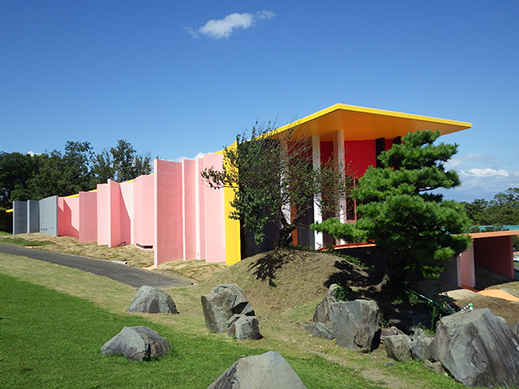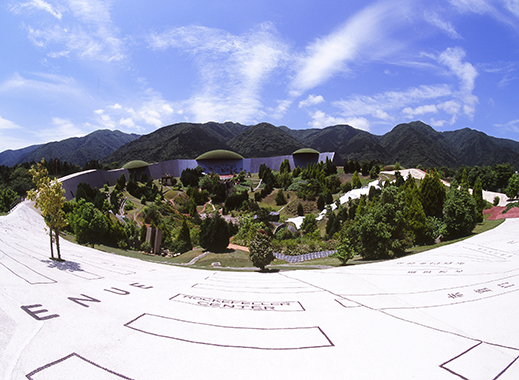 |
Focus features two in-depth reviews each month of fine art, architecture and design exhibitions and events at art museums, galleries and alternative spaces around Japan. The contributors are non-Japanese residents of Japan. |
|
|
 |
 |
 |
Reversing Destiny: Full-Body Immersion in a Radical Vision
Colin Smith |
 |
|
Inside the Reversible Destiny Office. |
It's not often you find a large-scale, high-concept interactive art environment that is also a fun-filled, family-friendly theme park, but the Site of Reversible Destiny in Yoro, Gifu Prefecture is that and more. It was designed by the artistic and architectural team of Shusaku Arakawa and Madeline Gins as part of their lifelong investigation into means of altering perceptions and challenging the body so as to "reverse our destinies" -- which generally involve growing dimmer and feebler and eventually dying -- and overcome death itself.
The roughly 18,000 square meter site contains structures with intriguing names (Trajectory Membrane Gate, Geographical Ghost, Zone of the Clearest Confusion), each of which has mechanisms like mazes, steeply sloping floors, and artificial horizons that disrupt visitors' senses of body, space, and perspective, encouraging them to return to the exploratory mode of toddlers. The site can indeed be enjoyed by actual toddlers and children, or anyone else regardless of degree of interest in conceptual or contemporary art. On a recent sultry day, several lively contingents of young women were busy taking selfies on various structures, or having them taken by the very obliging staff.
 |
|
|
Exterior view of the Reversible Destiny Office. |
The Site of Reversible Destiny is part of the larger Yoro Park, where you can hike to the impressive Yoro Falls, appropriately known in legend as a fountain of youth. Inside the site, the first pavilion is the Reversible Destiny Office, with undulating floors and a maze, duplicated on the ceiling, that tempts daring visitors to hop across the tops of the truncated walls (sometimes possible, sometimes not) -- one of many potentially risky activities that the park allows people to experiment with. Visitors should wear rubber-soled shoes, which are also loaned out free to the improperly shod at the reception area, as are helmets.
|
The roof of the Critical Resemblance House is shaped like a map of Gifu Prefecture.
|
The next stop is the Critical Resemblance House, another off-kilter labyrinth, which evokes an ordinary house with furniture and appliances suddenly cropping up in unexpected locations. In addition to much unbuilt utopian architecture, Arakawa and Gins designed actual dwellings that constantly challenge their inhabitants. One, the Reversible Destiny Lofts in the Tokyo suburb of Mitaka, is dedicated to the memory of Helen Keller, whose reversal of her own destiny they described as an inspiration. They also wrote extensively on philosophy in a scientific tone, in English (Nagoya-born Arakawa arrived in New York as a penniless young man and met his New York-born creative and life partner Gins soon after; they remained based in the US). The English version of the Yoro pamphlet contains far more detailed versions than does the Japanese of the designers' "Directions for Use" of the site. For the Critical Resemblance House, for example, "Enter several times, each time through a different entranceway . . . Move through the house as though you were presently living in it . . . Should an unexpected event occur, freeze in place for as long as you see fit." For the Destiny House and the Landing Site Depot, "Wander through as though you were an extra-terrestrial."
 |
|
From the "Directions for Use": In the Elliptical Field, "Instead of being fearful of losing your balance, look forward to it." |
Overall the site consists of a concave basin, the Elliptical Field, containing other pleasantly disorienting structures and various outdoor zones. Clambering up the Insect Mountain Range, a large anthill of loose rocks, is intended to encourage empathy with our six-legged brethren. Exactitude Ridge, a network of paths and trenches, connects different parts of the park and provides various physical experiences and visual perspectives. The perimeters of the park sometimes look like the edge of existence, while at other times the mountains in the distance appear, in a contemporary take on the "borrowed landscapes" of traditional Japanese gardens. Surfaces throughout are printed with greatly enlarged maps of surrounding Gifu Prefecture or urban grids in New York, Bangkok, and other major cities, interspersed with invented streets like the Road of Not Disappearing.
From the "Directions for Use": "In and about the Kinesthetic Path, repeat every action two or three times, once in slow motion." |
The Site of Reversible Destiny opened in 1995, well ahead of the recent wave of contemporary art installations and events in rural areas of Japan. The town of Yoro was admirably open to building such an avant-garde project far off the beaten path of the art world. While some of Arakawa and Gins's concepts are pretty hefty, and their message that "Dying can be outlawed" is a radical one, the site's terrain and structures require no knowledge or language, and offer unique body- and mind-exercising experiences to all comers. The environment is essentially open-air, so visiting at a temperate time of year is ideal. The walk up to the nearby waterfall is a popular course for autumn leaf viewing, and there are murky mineral-rich hot springs (Yoro Onsen) that do feel like they contain the waters of life.
After Arakawa's death in 2010, Gins was quoted in the New York Times as saying "This mortality thing is bad news." Gins herself died in 2014, but their largest realized creation continues to welcome us into a zone of surprising and delightful reversals.
All photos ©1997Estate of Madeline Gins. Reproduced with permission of the Estate of Madeline Gins. |
 |
| Site of Reversible Destiny |
1298-2 Takabayashi, Yoro-cho, Gifu Prefecture
Phone: 0584-32-4592
Hours: 9 a.m. to 5 p.m. Closed Monday (or Tuesday if Monday is a public holiday) and during the New Year holiday
Access: 10 minutes' walk or shuttle bus from Yoro Station on the Yoro Railway (accessible from Ogaki Station on the JR Tokaido Main Line) |
|
 |
 |
Colin Smith
Colin Smith is a translator and writer and a long-term resident of Osaka. His published writing includes the travel guide Getting Around Kyoto and Nara (Tuttle, 2015), and his translations, primarily on Japanese art, have appeared in From Postwar to Postmodern: Art in Japan 1945-1989: Primary Documents (MoMA Primary Documents, 2012) and many museum and gallery publications in Japan. |
|
 |
|